A self-study, self-paced course where you can learn how to paint in watercolor by watching video lessons and doing assignments
$297 USD
ENROLL NOWA self-study, self-paced course where you can learn how to paint in watercolor by watching video lessons and doing assignments
$297 USD
ENROLL NOWOne-to-one, unlimited and custom-tailored to your skills and needs Personal Tutoring by the Watercolor Academy teachers
$997 USD
ENROLL NOWBy Ilya Ibryaev
It is late afternoon and the marina is full of reflected light. This artwork I managed to make today. It depicts the marina, and includes boats with their reflections in water. Here is the artwork I will create by the end of this lesson.
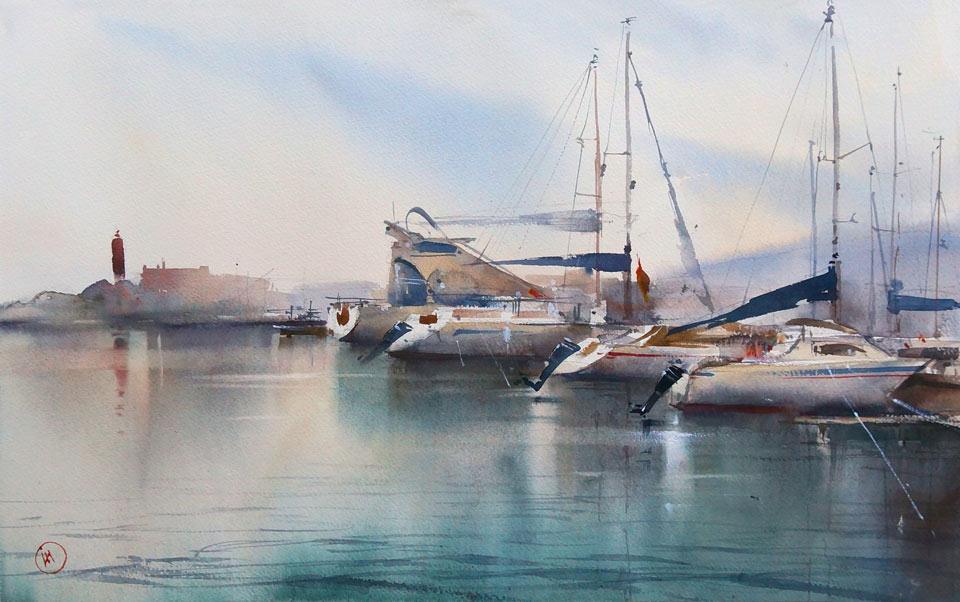
The artwork starts with a very laconic sketch in graphite pencil on watercolor paper. The sun is moving closer to the horizon, and is therefore in front of me. In this lesson, I will be painting the boats against the sunlight. I have a very limited time frame before sunset, so I will show you how to produce an impressionistic watercolor artwork very fast.
With the graphite sketch in place, I begin by mixing warm colors to depict the sky, including Cadmium orange, yellow ochre light and Cadmium yellow. This yellow tint is applied very lightly to represent the warm color of the sky near the horizon. Into this mix, I can also add Cadmium red, to give an impression of faraway clouds, which are colored by the sun. I am painting the sky with wide, loose brushstrokes, adding wet-into-wet, the mix of Ultramarine blue and Cadmium orange.
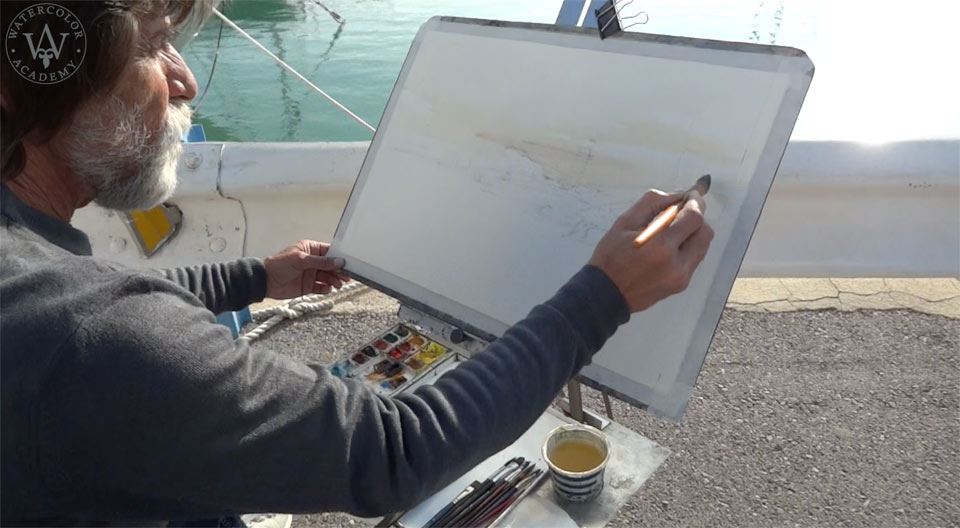
The board can be rotated at different angles, allowing wet paint to flow on paper and intermix into soft gradations of colors. While the board is upside down, I add a bit more Cadmium red. Before the paper dries, I can easily add, wet-into-wet, more saturated and darker blue colors, so that I successfully produce an impression of clouds in the sky. I am painting with a clear tint of Ultramarine, as well as a mix of Cadmium orange with this blue pigment. Rotating the board time to time helps to diffuse the paint even more. I am aiming to keep the sky very light. The sky is finished, so I wait for a couple of minutes for it to dry further, before I continue painting the rest of the artwork. The paper's glossy reflection tells me how wet it is; I therefore continue painting when the paper is satin. Half-dried paper helps to avoid sharp borders between washes. The hills on the background are far away, and appear light and pale. I leave the sky to dry a bit more. The background is painted with a flat, synthetic brush, which holds less water – this makes it easier to keep the tonal values under control.
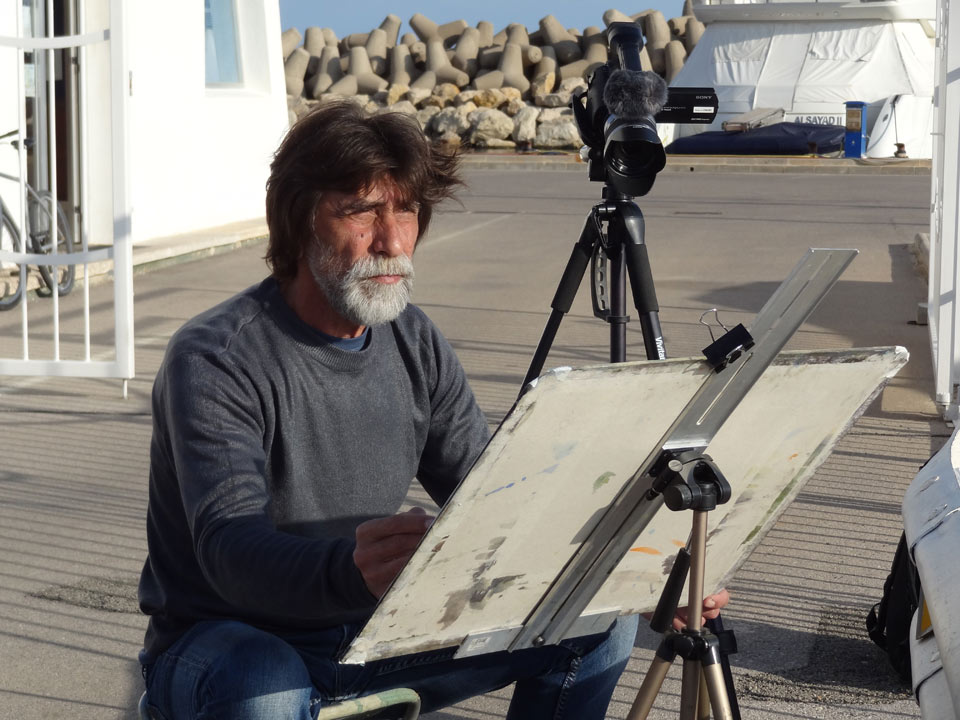
You may notice that the background is not made using one single color; I am adding different pigments into the mix, to make it more picturesque. There are several pigments which are used here, such as Ultramarine, Cadmium red and yellow ochre light. Such a combination allows us to produce a white gamut of color-temperature and tones. Both the darker values and higher saturation bring this part of the artwork closer to a viewer than the faraway hills. For the dark reflection, I am using dark green, Cadmium orange and yellow ochre. Fishing is prohibited in this marina, which is great for the small fish, which come here to live and grow.
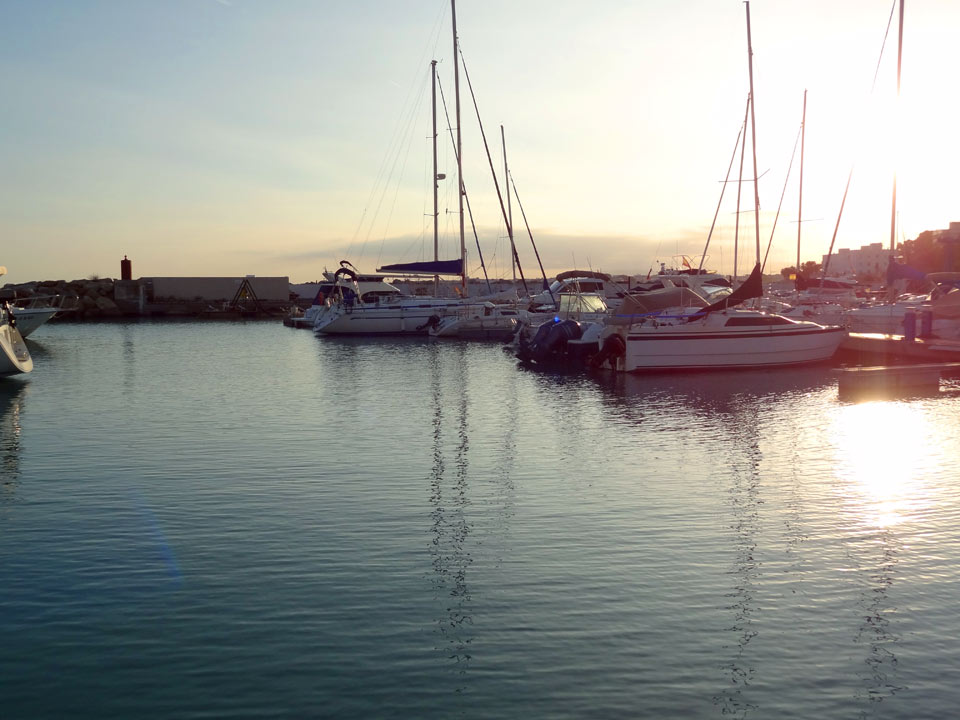
It's time to paint the yachts; for this purpose, I am using Cadmium orange, yellow ochre light and Ultramarine. With the first wash of the yacht in place, I can now add more Ultramarine and Cadmium orange mix, in order to make the color darker and colder. I am painting the yacht using both wet-into-wet and wet-on-dry techniques. Because I paint outdoors, the light is warm and the shadows are cold; so I add a bit more Ultramarine in order to paint shadow areas. Since reflected light is warmer, I add more yellow ochre light into the Ultramarine and Cadmium orange mix. Because of the sunset, the reflected light is warm; for the water which reflects this light, I am using yellow ochre light, Cadmium orange and Cadmium yellow. I also add some Cadmium red to this mix, to warm it up even further. The reflected light is always darker, so the water has to have darker values than the sky. I rotate the board to achieve a soft gradation of colors. While the board is upside down, I can add a few wide brushstrokes with clean water, in order to wet this area a bit more, so that paper will dry a bit slower, and give me a longer time to paint the water. With a round mop brush, I add cold Ultramarine, and rotate the board to diffuse these brushstrokes.
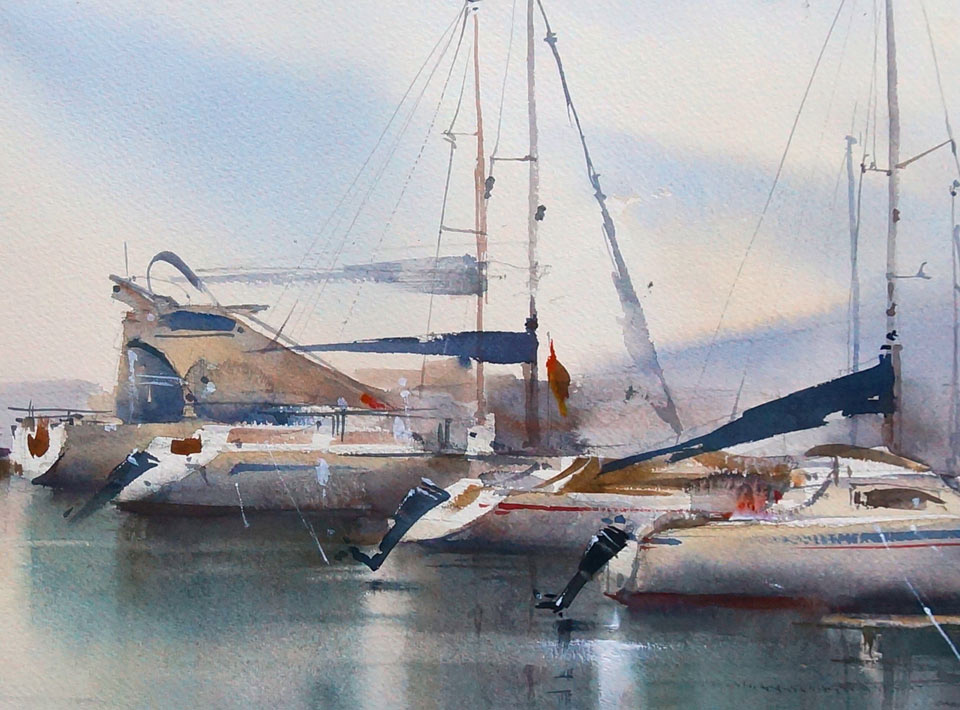
I paint water on the foreground with a mix of Ultramarine, dark green and Cadmium orange. I apply this mix in wide brushstrokes, and because the paper is wet, paint flows and intermixes with the first wash freely. I can also increase the saturation of color, by adding more warm Cadmium orange and cold Ultramarine, followed by a few brushstrokes to represent any dark reflections in this painting. I then rotate the board to mix the pigments on paper.
When pigments sink into paper fibers, the tonal values of colors become lighter. This is why I am adding even more Ultramarine, dark green, Cadmium orange and Cadmium red pigments into this wash. Also, I add a bit of Cadmium red, followed by Cadmium orange and Ultramarine to deepen up values of the sea water. This process can be repeated several times, until I achieve the required darkness of the water. Excess paint can be taken off with a damp brush. Placing the board upside down, and spraying it with clean water, helps to increase the flow. I can now paint the dark reflections using the dry-brush technique. There is a lot of pigment on the brush, but very little water. Because the paper is wet, the paint flows down, despite it being applied with a semi-dry brush. I am using a flat, synthetic brush, which holds very little water, to add in some reflections. I use the same brush to wipe off small waves on the water. With the sea now in place, we return to the yachts. I add the remaining boats using yellow ochre light and Ultramarine. A mix of Cadmium orange and Ultramarine is used for darker grayish colors.
I spray the paper with an atomizer, in order for the reflections of boats to be painted wet-into-wet. For such reflections, I use a mix of Cobalt turquoise light with yellow ochre light. I also add Ultramarine and Cadmium orange into this mix. I apply paint onto the paper using a wide flat brush, and smooth up the wide brushstrokes with a smaller synthetic flat brush. I add more pigment to make this reflection darker. Adding paints wet-into-wet creates soft borders between each brushstroke. Making gradients of colors is much easier with this painting technique. To make a beautiful watercolor artwork, an artist has to use different contrasts, such as a contrast between cold and warm colors, a light and dark contrast, a contrast of saturation, and so on.
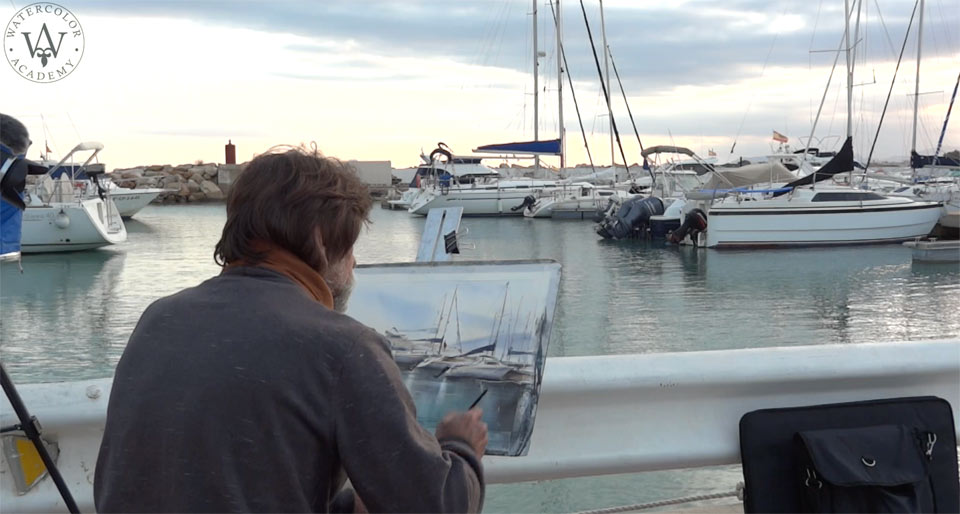
Now that all of the main washes are in place, it is time to work on the details. I am adding a yacht design using the Ultramarine pigment, although for warmer colors of this design, I use yellow ochre light and Cadmium red. The thin long lines are painted using a rigger brush; it has a long belly and holds more water than a normal small round brush. Vertical yacht masts and horizontal folded sails give an interesting rhythm to this artwork.
A self-study, self-paced course where you can learn how to paint in watercolor by watching video lessons and doing assignments
One-time payment - Lifetime membership
$297 USD
One-to-one, unlimited and custom-tailored to your skills and needs Personal Tutoring by the Watercolor Academy teachers
One-time payment - Lifetime membership
$997 USD